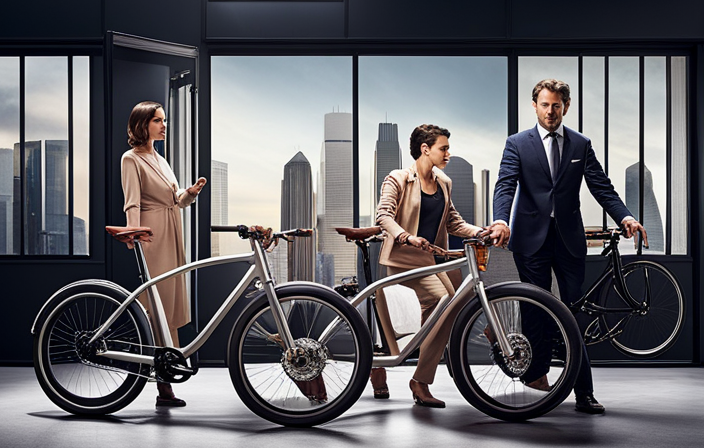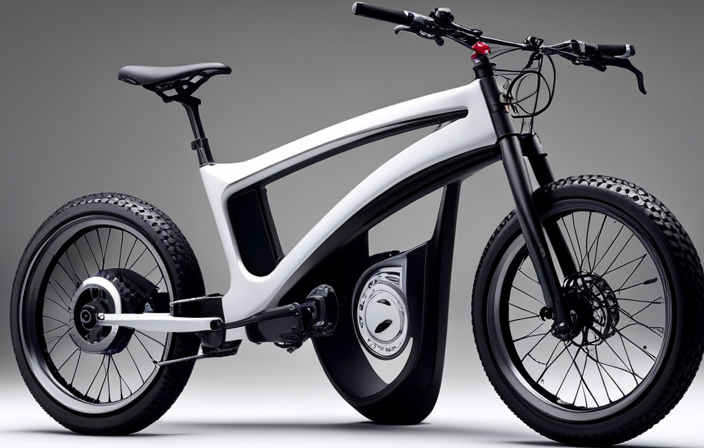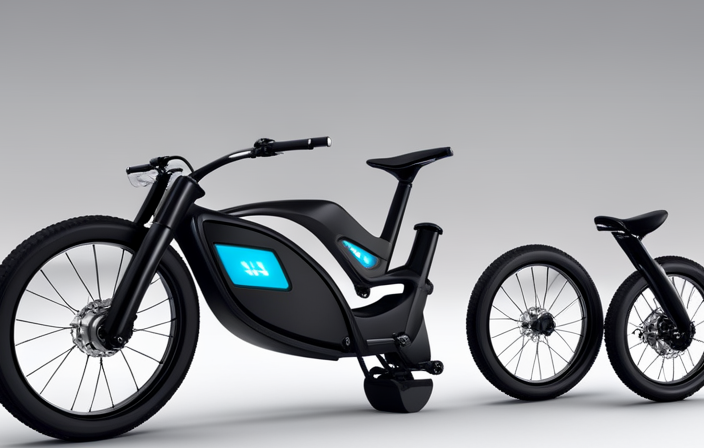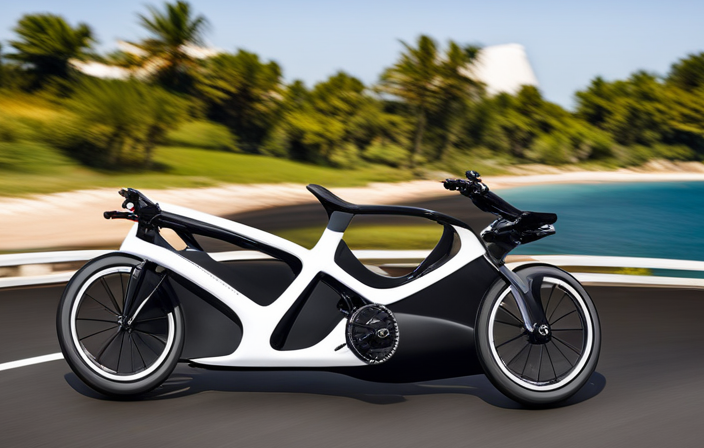As an avid cyclist, I can’t help but feel the exhilaration of the wind rushing through my hair as I ride my homemade bike.
In this article, I will guide you through the process of building both a regular bike and an electric bike.
With the right tools, materials, and a dash of determination, you’ll soon be cruising on your very own customized two-wheeled masterpiece.
So, let’s dive in and unlock the secrets to creating the perfect ride.
Key Takeaways
- Importance of Protective Gear
- Following Traffic Laws and Regulations
- Maintenance and Upkeep
- Tips for Improving Bike Performance
Gather the Necessary Tools and Materials
Before you can start assembling your bike, you’ll need to gather all the necessary tools and materials. When it comes to building a bike, having the right tools is crucial. Some of the essential tools you’ll need include a set of Allen wrenches, a screwdriver set, a pedal wrench, a torque wrench, and a chain tool.
In addition to these tools, you’ll also need various materials such as a bike frame, wheels, tires, brakes, gears, and a chain. The specific tools and materials you’ll need may vary depending on the type of bike you want to build. Whether you’re building a mountain bike, road bike, or hybrid bike, it’s important to have the appropriate tools and materials for the job.
Now that you have all the necessary tools and materials, let’s move on to choosing the type of bike you want to build.
Choose the Type of Bike You Want to Build
Decide on the kind of bicycle you want to construct. When it comes to building your own bike, you have the opportunity to choose between a regular bike and an electric bike. Let me break down the advantages of each option in a table for you:
| Regular Bike | Electric Bike |
|---|---|
| – Lightweight | – Motor assistance |
| – Easy maintenance | – Longer distances |
| – Affordable | – Faster speeds |
| – Eco-friendly | – Less physical effort |
Building a regular bike gives you the advantage of a lightweight and easy-to-maintain option at an affordable price. On the other hand, an electric bike provides the benefits of motor assistance for longer distances, faster speeds, and reduced physical effort. Now that you have an idea of the differences, let’s move on to the next section and select the frame and components for your chosen bike.
Select the Frame and Components
Once you’ve decided on the type of bicycle you want to build, it’s time to select the frame and components.
Choosing the right size frame is crucial for a comfortable and efficient ride. To determine the correct size, consider your height, inseam measurement, and riding style. Most manufacturers provide size charts to help you select the appropriate frame size.
Next, you need to select the right material for your frame. Common options include steel, aluminum, carbon fiber, and titanium. Each material has its own benefits and drawbacks in terms of weight, durability, and cost. Consider your budget and intended use to make the best decision.
Now, let’s move on to assembling the bike frame, where we’ll bring all the components together to create a solid foundation for your bicycle.
Assemble the Bike Frame
To begin assembling your bike frame, you’ll need to gather all the necessary components and tools. Start by selecting the right frame size for your height and riding style. A frame that is too small or too big can lead to discomfort and inefficient pedaling.
Once you have the correct size, ensure proper alignment of the bike components. This involves aligning the bottom bracket, headset, and dropouts to ensure they are parallel and perpendicular to each other. Use a level or a straight edge to check for any misalignment. Pay close attention to the angles and measurements to ensure a stable and well-functioning bike.
With the frame properly aligned, you are now ready to move on to the next step – installing the bike components.
Install the Bike Components
Now that the frame is aligned, you can start installing the components onto the bike. The bike installation process involves carefully attaching the handlebars, seat, pedals, and wheels to ensure a safe and functional ride.
Begin by securely fastening the handlebars to the stem using an Allen wrench. Next, insert the seat post into the frame and tighten it with a quick-release or bolt, depending on your bike model. Attach the pedals by matching the threads and turning them clockwise until they are secure. Finally, align the wheels with the dropouts and firmly tighten the quick-release skewers or axle nuts.
During the installation process, it is important to troubleshoot common installation issues such as loose bolts or misaligned components. Ensure that all bolts are tightened to the recommended torque specifications to prevent any potential accidents. Additionally, make sure the handlebars are centered and the wheels spin freely without any wobbling.
With all the components properly installed, it is time to test and adjust the bike for optimal performance.
Test and Adjust the Bike
First, ensure that the brakes are properly aligned and functioning by squeezing the brake levers. This will help you determine if there are any issues with the brake system that need to be addressed.
Once you have tested the brakes, it is time to move on to other important bike adjustments. One crucial adjustment is checking the tire pressure to ensure optimal performance and prevent any potential accidents.
Another adjustment to focus on is the seat height, which should be adjusted to provide maximum comfort and efficiency while riding.
Lastly, don’t forget to check the chain tension and lubrication, as this can greatly affect the bike’s performance.
Paint and Customize Your Bike
Once you’ve finished adjusting your bike, it’s time to personalize it by painting and customizing it to reflect your unique style. Here are four custom bike design ideas and spray painting techniques to consider:
-
Custom decals: Create your own unique decals or choose from pre-made designs to add flair to your bike frame and components.
-
Colorful frame accents: Use masking tape to create clean lines and patterns on your bike frame. Spray paint with your chosen colors to add a pop of personality.
-
Airbrushing: With an airbrush kit, you can create intricate designs and gradients on your bike. Experiment with different stencils and techniques for a truly customized look.
-
Custom handlebar tape: Choose a color or pattern that complements your bike frame and wrap it around your handlebars for a stylish touch.
Now that your bike is looking great, let’s move on to safety considerations for riding your newly customized bike.
Safety Considerations
When it comes to cycling, safety should always be a top priority.
To ensure your well-being on the road, it is crucial to wear protective gear such as helmets, knee pads, and reflective clothing.
Additionally, it is essential to follow all traffic laws and regulations, including stopping at red lights, yielding to pedestrians, and using hand signals to indicate your intentions.
Wear Protective Gear
Make sure to wear protective gear, such as a helmet and knee pads, to stay safe while riding both regular and electric bikes. Choosing the right protective gear is crucial for ensuring your safety on the road.
A well-fitting helmet is essential to protect your head from potential injuries in case of a fall or collision. Knee pads provide additional protection for your joints, minimizing the risk of fractures or sprains.
Wearing protective gear is not just a matter of personal preference; it is of utmost importance during bike rides. Accidents can happen unexpectedly, and having the right gear can significantly reduce the severity of injuries. By wearing protective gear, you are taking a proactive approach to safeguarding yourself from potential harm.
Now, let’s move on to the next section, where we will discuss the importance of following traffic laws and regulations.
Follow Traffic Laws and Regulations
Remember to always follow traffic laws and regulations while riding to ensure your safety on the road. Road safety is of utmost importance, and by adhering to traffic laws, you can minimize the risk of accidents and protect yourself and others.
Avoiding traffic violations is crucial, as they not only put your safety at risk but also result in legal consequences. Be familiar with the rules for cyclists, such as using appropriate hand signals, obeying traffic signals, and yielding to pedestrians.
Additionally, maintain a safe distance from vehicles and ride in the designated bike lanes whenever possible. By being a responsible and law-abiding cyclist, you contribute to creating a safer environment for everyone on the road.
Speaking of road safety, let’s now move on to the next section about the maintenance and upkeep of your bike.
Maintenance and Upkeep
It’s important to regularly check the tire pressure on both your regular bike and electric bike. Maintaining the correct tire pressure is crucial for optimal performance and safety. Here are some maintenance tips and troubleshooting common issues to keep your bikes running smoothly:
| Maintenance Tips | Troubleshooting Common Issues |
|---|---|
| Regularly clean and lubricate the drivetrain | Strange noises coming from the motor |
| Inspect brake pads for wear and replace if necessary | Battery not holding a charge |
| Check and tighten all bolts and screws | Sudden loss of power |
| Keep the chains properly tensioned | Error codes displayed on the control panel |
Enjoy Your Homemade Bike
After ensuring the regular maintenance and upkeep of your homemade bike, the next step is to enjoy the fruits of your labor. However, there are still some challenges that you might encounter along the way. Fear not, for I am here to provide you with some tips for improving your bike’s performance and making your riding experience even more enjoyable.
Here are some useful tips:
-
Proper tire inflation: Maintaining the correct tire pressure will not only improve your bike’s performance but also ensure a smoother and more comfortable ride.
-
Regular chain lubrication: Keeping your bike’s chain well-lubricated will enhance its efficiency and prevent unnecessary wear and tear.
-
Adjusting the brakes: Properly adjusted brakes will provide you with better control over your bike and ensure your safety on the road.
-
Optimizing gear shifting: Understanding how to shift gears effectively will help you maintain a steady and efficient pace while riding.
-
Upgrading components: Consider upgrading certain components, such as the saddle, pedals, or handlebars, to improve comfort and performance.
Frequently Asked Questions
How much does it cost to build a regular bike or electric bike?
The cost comparison between building a regular bike and an electric bike can vary depending on various factors such as the quality of components chosen. However, building your own bike has the benefit of customization and potentially saving money compared to buying a pre-built bike.
Can I use any type of bike frame for building an electric bike?
It is important to choose a bike frame compatible with an electric bike. A frame designed for electric bikes offers advantages such as reinforced structure, better weight distribution, and integrated cable routing for a seamless and efficient electric bike conversion.
What tools and materials are needed specifically for building an electric bike?
To build an electric bike, you will need tools like wrenches, screwdrivers, and wire cutters, as well as materials such as a motor, battery, controller, and throttle. The cost of components can vary, but a step-by-step building process is essential.
Are there any safety considerations or regulations to keep in mind when building an electric bike?
When building an electric bike, it is crucial to prioritize electric bike safety and legal regulations. Adhering to safety guidelines such as wearing a helmet and following traffic laws ensures a secure and legal riding experience.
How often does a homemade bike require maintenance and what kind of upkeep is involved?
The frequency of maintenance for a homemade bike depends on various factors such as usage and environmental conditions. Tasks may include cleaning, lubricating, and adjusting components, as well as regularly inspecting for wear and tear.
Conclusion
In conclusion, building your own bike can be an incredibly rewarding experience. By following the steps outlined in this article, you can create a unique and customized bike that suits your preferences and needs.
From choosing the right frame to installing the components, every step requires attention to detail and technical know-how. Though it may seem daunting at first, the satisfaction of riding a bike that you built with your own hands is unparalleled.
So go ahead and embark on this adventure, and you’ll soon be cruising on your very own masterpiece, feeling like the king of the road.









